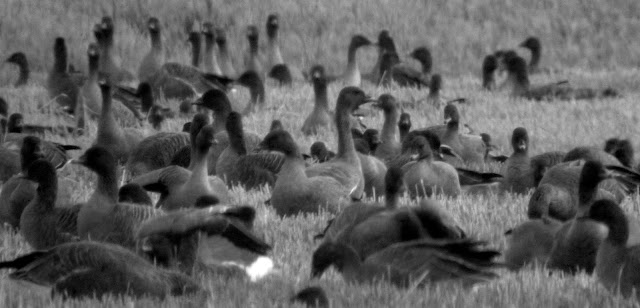I was working over in County Down at Castle Espie on Friday. I've made a few work trips there over during the past couple of years. It's always a joy to visit and it bring backs memories of 1991, the year I spent working there.
Although on Friday my primary reason for visiting wasn't related to counting geese, reserve manager Kerry politely insited I help him with the International Light-bellied Brent Goose census, and how could I refuse my hosts invitation? Kerry coordinates the goose counting on Strangford Lough and counts sectors roughly west of Newtonards along the west coast of the lough down to Mahee island.We counted c.8000 in Kerry's sector, the final count for the lough was 22926 (down on recent counts, some have moved south already). Productivity has apparently been very low this year, I looked closely at a sample of 980 birds and could only find 10 juveniles. Amazing to think that these wonderful little geese migrate to Ireland via Greenland and Iceland (and beyond; some winter on Hilbre Island, Angelsey and in Brittany) and breed in the Canadian high arctic. The wonders of migration.....
We started the count at 8.30 and had finished by 10.45, the rest of the day was spent in the confines of an office, so it was nice to get an early goose fix. Other birds seen on and around the lough included 260 Eiders, Red-breasted Merganser, Little Egret, Greenshank, c.10 Great Crested Grebes, Twite, Chiffchaff and big flocks of waders that contained Dunlin, Knot and Bar-tailed Godwits.
Light-bellied Brents grazing zostera on theStrangford Lough mudflats.
A captive Light-bellied Brent at WWT Castle Espie.
The north-western end of Strangford Lough from Castle Espie, looking towards Scrabo tower. Great Brent habitat.
Looking from Mahee, north towards Scrabo
Rainbow from Castle Espie, taken on March 2012.


